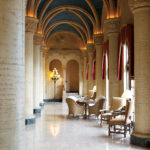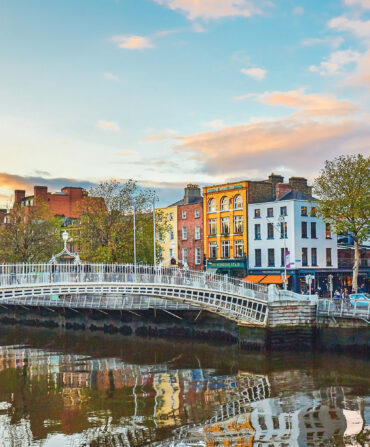I had a house in Miami, once. Well, it was in Coral Gables, just across LeJeune Road and the city limit line, but my cat lived in Miami and came and went through four lanes of traffic, unafraid. I know he was not a full-time Coral Gables cat because he did not have his shots and did not have a collar with little bells on it, and did not even have both his ears.
He came with the house. He was as black as the bottom of a well and stitched with scars, and his tail had been broken so badly it jutted out perpendicular to his body, so that when he skulked around the yard, hunting lizards, it always looked like he was signaling a hard left turn. I named him Mofongo because I mostly fed him leftover garlic-flavored mashed-up and deep-fried green plantains, and because Mofongo had a better ring to it than “ham croqueta.” But most of the people on my street thought his name was “Come here you fuzzy bastard,” because that was all he answered to, when he would come at all. I think, now, it was because I was calling him in English. He was a Miami cat, and so spoke Spanish, solamente.
So it was my own fault that he was the way he was. Not speaking Spanish in Miami is like working at the New York Stock Exchange and not being able to count. Mofongo had every right to expect me to habla. He was born here. Over three years, he bit anyone who tried to pet him. I loved that cat.
I think about him now and then and it always makes me smile, and that is what a memory should do if it is any damn good. Miami is like that for me. It bit me more than once, and while it was sometimes not pretty it was never dull. Miami is across the world from dull. I have always imagined that I was on the edge of something here, a jumping-off place to even hotter, damper, more dangerous shores.

Photo: Matthew Hranek
A Cuban sandwich in Little Havana.
Most of what I remember of my time here, seven years or so, off and on, has been romanticized a little, I suppose. I remember being neck-deep in blue water, the Atlantic and the Caribbean swirling together at my back, my eyes resting on sand covered in soon-to-be supermodels, as the air above my head swirled with good music, the words of which I could not comprehend. This was a place where much of the architecture seemed peeled from a child’s cartoons and stuck on the dingy sand between a blue sea and a great, liquid land, where the air seemed to always smell of strong coffee and hibiscus with just the tiniest taste of gunpowder, though I am probably just being romantic about that, too. I remember it as a place where, if you ordered a glass of Barbancourt, the dangerous Haitian rum, the bartender did not look at you as if you had asked for eye of newt. When I first came here, in the dawn of the 1990s, it was a place where old men still trained in the Everglades to overthrow the murderer Fidel, telling tales of a prison called la escalera as they reclined beside a great, bubbling pot of baccalau. Parrots, escapees from Monkey Jungle, nested in the banyan trees. It was not always like that, this city, but that is what I will choose to recall.
I lived here twice, both times writing for a living, chasing wonderful stories but probably not very hard. It was hard to dwell on work here, unthinkable to twist on a tie. And sometimes it was safer not to work at all. I was knocked goofy here, twenty years ago, hit on the head with a rock on a violent night, blundering around in one of the city’s more minor race riots. That, as my kinfolks say, should have learned me, should have educated me about pretending to try to make sense of a place that defied sense, then, always. I left it for New Orleans, the last time, which is like trading one mean cat for another.
In my absence, it would hardly grow less interesting. This is where, last spring, a naked man chewed the face off a homeless man on the MacArthur Causeway before being shot dead by the police. When I lived here, the worst thing that might bite you was an alligator in the storm drain. Now pythons writhe across residential roads and have eaten many of the small mammals in the Everglades. There are still machine-gun murders in Little Haiti and election rigging in Hialeah—election rigging is a sport here—but I do not chase such things anymore. The biting has increased too much to suit me.
Now that I am older, I come back once or twice a year and behave like the tourist I should have been all along. I get a room at the Biltmore in the Gables—the only thing that ever bit me there was a crab that made its way into the pool—or the Winter Haven on South Beach, where a bartender used to put a sacrilegious splash of 7Up in his mojitos…but what do you expect for seven dollars and change.
I do not know what is hip and new and trendy in Miami. Mofongo and I, we never sweated trends all that much. I come here now and then and go to see what has survived from the Miami I built in my own mind, and am always a little surprised to find that those things have not slipped over the edge and disappeared.
The place still loves a sucker. You still have to slip a twenty into the hand of the gatekeeper at Joe’s, for the best stone crabs on this earth, though—to be truthful—a twenty won’t get you one damn minute closer. It is just tradition. I would feel bad if I didn’t do it, as if I were in Seattle and didn’t go see someone throw a fish.
I still go to a place on Coral Way called Villa Habana, where the mirrored walls and the polite waiters seem lifted from the 1950s. The sweet plantains still taste like candy, and I let them cool just a little as machine-gun Spanish flies over my head. This is what it is like to be invisible, I believe, because a thousand years of Berlitz won’t help you speak it like this. But there is an odd comfort in that, too. I do not mind being invisible if there is roast pork with onions, doused in an elixir of lime juice, olive oil, diced garlic and cilantro, and a side of black beans and yellow rice. The café con leche is still the best cup of coffee I have ever had, and the flan is thick and rich. This is not a tourist place, and it survives on the front lines of change; they have opened a Hooters across the street. But Villa Habana endures. It rained in gray sheets the last time I was here. An old man in the parking lot opened an umbrella and walked old ladies to their cars. Me, he left to run for it through the monsoon.

Photo: Matthew Hranek
Tres leches cake from Versailles.
For a dose of politics, I go to the Versailles restaurant and bakery, where the old men will even discuss Fidel and Raul in a mix of Spanish and English, just to be polite to me, though bastardo is pretty self-evident, I suppose. Friends, Cubanos and Cubanas, tell me Fidel has outlived many of his detractors here, while others say they will outlive him if they have to last a thousand years. I go by the house where the boy Elian Gonzalez lived, briefly, at the center of an ugly international custody battle, before he was taken by federal agents and returned to his father to live in Cuba. His mother drowned trying to get here. For years, the small house in Little Havana was a shrine, its fence covered in flowers and pictures and prayers; now a single pink carnation is fixed to the chain link. Old refugees still walk the sidewalks here, looking back on a Cuba to which they will probably never return. So much time has passed; so much life has been lived here. This is finally home, or maybe only the edge of it, still.
In Little Haiti, amid the gunfire, people stand and look back on the horrors across the water, and say they will stay, too, “of course.” They used to sell good macaroons here. A man on a street corner sold coconuts from an iced-down tub and would cut the top off for you with a machete as sharp as a scalpel, and stick in a straw.
It is easy to romanticize such a place. Maybe that is why I still like to drive out to Key Biscayne, find a seawall, and just sit, on the edge.
My last afternoon of a recent visit, I considered going to hear some songs, find some old Cuban band music, maybe even some salsa where I could watch the young people dance. But it was a football Saturday, and I have a ritual for that, when I am here. I called in an order at La Carreta on Calle Ocho, the same order I have been calling in for nearly a quarter century: croquetas de jamon (ham), maduros (sweet plantains), and arroz imperial, a chicken and yellow rice decorated with pimiento, boiled egg, and a treacle of mayonnaise. I still speak poor to nonexistent Spanish, but when it comes to ordering takeout at La Carreta, I am Ricky Ricardo. My mama named me for him. I watched a game or two, till it was dark, and then walked outside into the warm, damp air, toward the house I used to own.
I wonder about Mofongo. He would be long gone by now, chasing lizards across the sky. He was still here when I moved away the last time, a decade or so ago. The nice lady who bought the house said she loved cats and left, immediately, to get him a sack of cat food.
I was not sure he would eat the cat food. I should have told her that.
He was a Miami cat.
Just throw a croqueta out the door, I should have said.
It wouldn’t even hit the ground.










